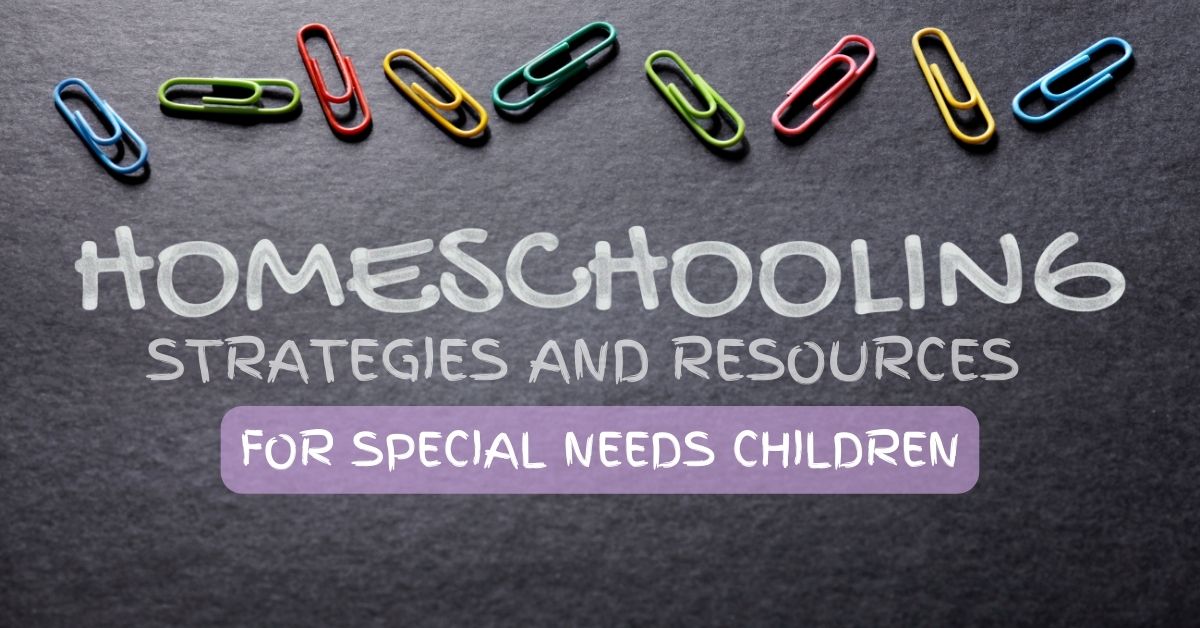Homeschooling a child with special needs can feel like a daunting task, but it also offers unique rewards and opportunities that traditional schooling may not provide. For parents who choose this path, understanding the distinct challenges and developing effective strategies is crucial. This post aims to guide you through the process, offering practical tips and resources to make homeschooling a fulfilling and successful experience for both you and your child.
Homeschooling special needs children comes with its own set of challenges, but the rewards can be immense. The personalized attention you can offer will help your child learn at their own pace while focusing on their unique strengths and needs. This blog post will provide you with strategies and resources to help you create an effective homeschool environment that supports your child’s education and overall well-being.
Strategies For Homeschooling Special Needs Children
Every child has a unique way of learning, and this is especially true for children with special needs. Some may be visual learners, while others may grasp concepts better through auditory or kinesthetic methods. Understanding your child’s learning style is the first step in creating a homeschool curriculum for special needs. Observe how your child interacts with different types of materials and activities to determine their preferred learning mode. This insight will help you tailor lessons that make learning more effective and enjoyable for your child. Additionally, it’s important to recognize that your child’s learning style might evolve over time. Regularly reassessing how they respond to different teaching methods can help you adapt your approach as needed. Consultation with educational psychologists or specialists can also provide valuable insights into your child’s unique learning needs.
The environment in which your child learns plays a significant role in their educational success. Creating a dedicated, distraction-free space for homeschooling can help your child focus better. Ensure that the area is well-lit, organized, and equipped with all the necessary materials. Incorporating elements that your child finds comforting, such as sensory toys or calming colors, can also make the space more conducive to learning. Flexibility is key when setting up your homeschool environment. While a structured space is important, allowing for occasional changes in scenery, such as outdoor learning or a cozy reading corner, can keep your child engaged. The goal is to create a versatile environment that can adapt to your child’s evolving needs and preferences.
Technology can be a powerful ally in homeschooling special needs children. From interactive apps to specialized software, there are numerous tools designed to address various learning challenges. For instance, speech-to-text programs can assist children with dyslexia, while visual scheduling apps can help those with autism manage their time effectively. The key is to find tools that align with your child’s specific needs and integrate them seamlessly into your homeschool curriculum for special needs. Educational websites and apps tailored for special needs can offer additional support. Resources like Khan Academy, ABCmouse, and Prodigy provide engaging and interactive lessons that cater to different learning styles. These platforms often include adaptive features that adjust the difficulty level based on your child’s progress, ensuring a personalized learning experience.

Consistency is crucial for children with special needs, making a well-structured schedule an essential component of your homeschool plan. A predictable routine helps your child understand what to expect each day, reducing anxiety and promoting focus. Design a daily schedule that includes time for lessons, breaks, physical activities, and leisure. Be sure to incorporate flexibility to accommodate your child’s energy levels and attention span. Using visual schedules can be particularly beneficial for children with autism or ADHD. These tools provide a clear visual representation of the day’s activities, helping your child transition smoothly from one task to the next. Over time, following a consistent routine can improve your child’s ability to manage their time and complete tasks independently.
Breaks and physical activities are vital for maintaining your child’s overall well-being and enhancing their ability to focus. Incorporating short breaks between lessons allows your child to recharge and prevents burnout. Activities like stretching, jumping jacks, or a quick walk can help release pent-up energy and improve concentration. For children with sensory processing issues, sensory breaks that involve activities like swinging, bouncing, or deep pressure can be particularly beneficial. Physical activities also play a role in your child’s social and emotional development. Group activities, such as joining a sports team or participating in community events, provide opportunities for social interaction and teamwork. Encouraging your child to engage in physical activities they enjoy can foster a positive attitude towards exercise and contribute to their overall health.
Resources For Homeschooling Special Needs Children
Connecting with other parents who homeschool their special needs children can provide invaluable support and encouragement. Online communities and support groups offer a platform to share experiences, exchange tips, and seek advice. Websites like Homeschooling Special Needs and Facebook groups dedicated to special needs homeschooling near me can help you find like-minded individuals who understand your challenges and triumphs. These communities often host webinars, virtual meetups, and workshops that provide additional learning opportunities. Participating in these events can broaden your knowledge, introduce you to new strategies and resources, and help you build a supportive network.
In today’s digital age, there is no shortage of educational resources designed to support special needs homeschooling. Websites like Understood and Learning Ally offer a wealth of information, including articles, videos, and toolkits tailored to various learning disabilities. Apps like Proloquo2Go and Dragon Dictation provide assistive technology that can enhance communication and learning for children with speech and language difficulties. It’s important to regularly explore and update your list of resources to keep your child’s learning experience fresh and engaging. Many educational platforms offer free trials or discounted memberships for homeschooling families, allowing you to test different tools and find the best fit for your child’s needs.
Ensuring that your child has access to educational materials that cater to their specific needs is crucial for their success. Adaptive resources, such as large print books, audiobooks, and tactile learning aids, can make learning more accessible and enjoyable. Organizations like the National Library Service and Bookshare provide a wide range of accessible materials for children with visual impairments or reading disabilities. Additionally, incorporating multisensory learning materials into your homeschool curriculum can help reinforce concepts and improve retention. Hands-on activities, such as using manipulatives for math or conducting science experiments, engage multiple senses and make learning more interactive and fun.
Customizing Homeschooling Plans
One of the greatest advantages of homeschooling is the ability to tailor your child’s education to their unique needs and strengths. Customizing your homeschool curriculum for special needs allows you to focus on your child’s interests, address their challenges, and pace their learning according to their capabilities. This personalized approach fosters a love of learning and helps your child develop confidence and self-awareness. Custom plans also provide the flexibility to incorporate therapies and interventions that support your child’s development. Whether it’s speech therapy, occupational therapy, or social skills training, integrating these services into your homeschool routine ensures a holistic approach to your child’s education.
Creating a personalized homeschool curriculum involves understanding your child’s learning style, setting realistic goals, and selecting appropriate materials and activities. Start by identifying your child’s strengths, interests, and areas that need improvement. Use this information to set short-term and long-term goals that are achievable and measurable. When selecting materials, consider incorporating a mix of textbooks, digital resources, and hands-on activities to cater to different learning styles. Be open to experimenting with different approaches and adjusting your plan based on your child’s progress and feedback. Regularly reviewing and updating your curriculum ensures that it remains relevant and effective.
Flexibility is a key component of successful homeschooling. While having a structured plan is important, it’s equally crucial to be adaptable and responsive to your child’s needs. Monitor your child’s progress regularly and make adjustments as needed. If a particular approach isn’t working, don’t hesitate to try something new. Remember, the goal is to create a positive and supportive learning environment that fosters growth and development. Being open to change also means recognizing when it’s time to seek additional support. Whether it’s consulting with specialists, joining support groups, or enrolling in supplementary programs, leveraging external resources can enhance your homeschooling experience and provide valuable assistance.
A Rewarding And Enriching Experience
Homeschooling special needs children can be a rewarding and enriching experience for both parents and children. By understanding your child’s unique learning style, creating a supportive environment, and utilizing available resources, you can provide a tailored education that meets their needs and nurtures their potential. Remember, you’re not alone on this journey—there are many communities and resources available to support you along the way.





